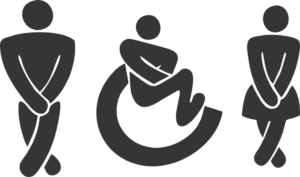Pelvic Floor Therapy for Urinary Incontinence
One of the top reasons patients seek pelvic floor therapy in my practice is to address urinary incontinence.
What Are the Different Types of Incontinence?
Urinary incontinence, or the involuntary loss of urine, can be broken down into 3 different categories: urge, stress, and mixed incontinence.
Urge incontinence is the involuntary loss of urine immediately after the sensation of urgency. This can be due to the bladder contracting abnormally, giving you the strong sensation you need to urinate. This signal can be strong and, unfortunately, difficult to control, leading to urine leakage.
Stress incontinence is the involuntary loss of urine during events like sneezing, coughing, laughing, and running, to name a few. The effort these activities take can increase abdominal pressure, which ultimately stresses the bladder, resulting in leakage.
Mixed incontinence is the experience of urine leakage related to both urgency and exertion.

What Commonly Causes Urinary Incontinence?
- Childbirth
- Genitourinary syndrome of menopause (vaginal atrophy)
- Urinary tract infections
- Neurological disorders
- Medications
- Bladder irritants like alcohol and excessive caffeine
- Chronic constipation

Urinary incontinence can be distressing and life-altering. Depending on the severity of symptoms, some people experience reduced social interactions, as well as decreased physical and sexual activity. Overall, this can lead to poor emotional and mental well-being. Fortunately, there is evidence that therapy can improve quality of life and improve symptoms in people who experience urinary incontinence, and I have seen this in my practice.
What is Pelvic Floor Therapy?
Pelvic floor therapy is a treatment that helps to reconnect the pelvic floor muscles with the surrounding areas of the body. It is a non-invasive therapy that focuses on treating muscle weakness and joint alignment issues that can lead to pelvic pain and dysfunction. Personalized exercises, posture correction, habit retraining, and education are all part of the therapy that can effectively treat pelvic floor issues.
What are the Benefits of Seeing a Pelvic Floor Therapist?
Pelvic floor therapy can:
- Strengthen pelvic floor muscles and nerves
- Increase coordination and flexibility
- Realign affected joints
- Improve bladder and bowel control
- Improve sexual satisfaction
- Help you return to normal daily activities faster
- Improve pelvic organ support
- Help you engage your core muscles
- Alleviation of Pelvic pain
- Pre and postnatal benefits
How Can Pelvic Floor Therapy Help with Incontinence?
Therapy can support the muscles that support the urethra and bladder, often improving and even resolving symptoms. This can look like manual therapy, exercises at home, and additional support with modifying dietary and lifestyle factors. In my practice specifically, after a thorough history collection and physical exam to ensure a proper diagnosis, I utilize pelvic floor therapy, movement, nutrition, and, when appropriate, probiotics specifically for the urogenital microbiome to support symptoms.
Who is a Good Candidate for Pelvic Floor Physical Therapy?
If you are experiencing urinary incontinence, therapy can be an excellent solution for your problem. If you are unable to locate your pelvic floor muscles or want to ensure that you are doing the pelvic floor exercises recommended by your doctor correctly, you should consider visiting a pelvic floor therapist. This type of therapy produces the most noticeable results in people with mild-to-moderate urine leakage. If you have severe symptoms, you may need medications and other treatments on top of exercises to improve your symptoms. Remember that pelvic floor physical therapy can be a slow process, taking months to show benefits, and success may vary from person to person.

How Can I Start Pelvic Floor Therapy?
If urinary incontinence is something you’re experiencing, you don’t have to journey through this alone. The first step is finding a provider who you can share your story with. The next important thing to know is that supporting incontinence is not going to be a quick fix, but you can start to experience symptom relief little by little each day. If you are curious about pelvic floor therapy for incontinence, I encourage you to schedule a free 15-minute consult with me to get more information about this modality and if it is right for you.
Related Article:





